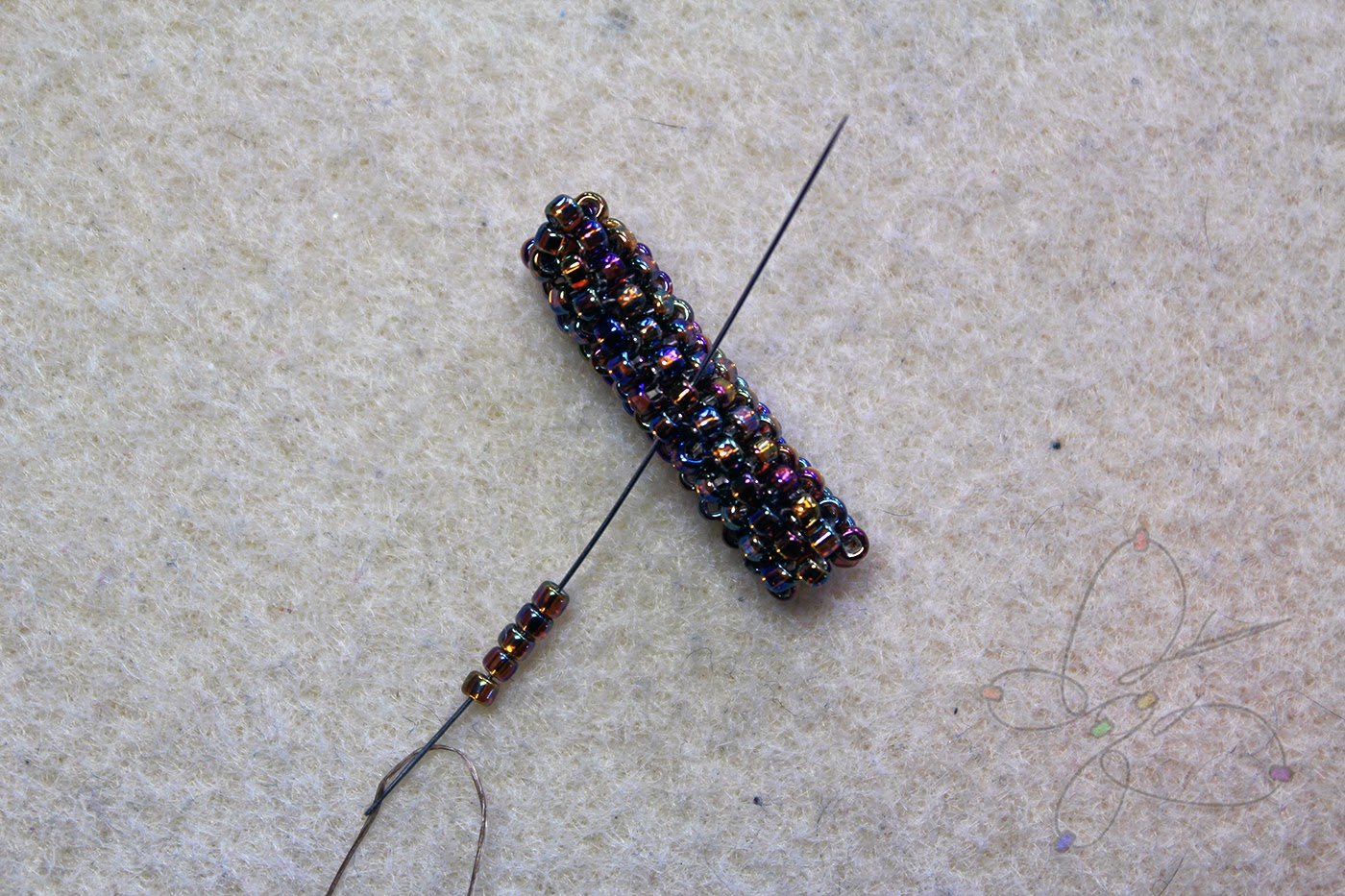Beadweaving, by its nature, requires thread as well as
beads. But what kind of thread is best? Different beadweaving artists will
answer this question different ways. Here’s my take on thread.
Without a doubt, my go-to thread is Nymo D, a multi-filament
nylon thread. (“D” refers to the weight of the thread; O, OO, and B are other
weights available, all of which are lower test weight than Nymo D). I love
that Nymo D allows for a very graceful, unencumbered drape while simultaneously
permitting tight tension that can be used to stiffen a piece of beadweaving. I
also find it relatively easy to thread onto a beading needle. It comes in a
wide range of colors, making it easy to hide thread paths and knots amidst the
beads. And, if properly cared for, a piece made with Nymo D will last for
years, even with frequent wear.
Other popular brands of multi-filament nylon thread exist. A
few other brands worth mentioning are Silamide, Silkon, and C-Lon. I don’t have
as much experience with any of these brands as I do with Nymo, but I find
Silamide to be far more difficult to thread onto a beading needle than I do Nymo.
Silk beading thread is also available, and it’s recommended for use with pearl
and gemstone beads, but I have never used silk beading thread and I have never
had any problems with using nylon beading thread with pearls or gemstones.
There are, however, characteristics of Nymo (and multi-filament nylon
threads in general) that make it less than ideal under certain conditions. It
won’t stand up for long against the sharp edges of bugle beads or other beads
with sharp edges around their drill-holes. It also doesn’t survive long when
exposed to corrosives or chemicals, even ones as mild as hand soap. I avoid
wearing jewelry I’ve made with Nymo after I’ve applied sunscreen or lotion, and
I make sure my hands are completely dry before handling or wearing pieces made
with Nymo. For situations in which I need my work to resist degradation when
exposed to water and chemicals, I turn to another popular type of beading
thread: Berkley Fireline.
Berkley Fireline is a product manufactured as a fishing line. It’s in a family of fishing lines
known as “superlines”, which are formed from multiple filaments “fused”
together with a bonding agent. (In the case of Fireline, the filaments are made
from extruded polyethylene.) This bonding of multiple filaments makes it
possible to achieve a higher test rating with a far smaller diameter when
compared to monofilament fishing lines. Since it’s made for use in fishing,
Fireline stands up to water and many types of corrosives, and it’s generally
held to have a very long life even when left out in the elements. (For a nice
discussion of comparative fishing lines, see this article.) Of course, every option has drawbacks, and one of Fireline’s biggest
problems is how expensive it is. 128 yards of Nymo D sells for under $4, while
125 yards of 4lb-test Fireline sells for over $17. Due to its high price, Fireline
is not the thread to experiment with, nor is it an affordable way to create
samples. Repeated disassembly of weaving made with Fireline will wear down the
bonding agent, reducing the strength and aesthetic appeal of the thread. And
color choices for Fireline are extremely limited. In my experience, the “crystal”
Fireline doesn’t disappear into the beads the way you might expect; it looks white, and against dark beads it can
be extremely visible. I also don’t care for the drape achieved with Fireline,
which is a big reason why I default to using Nymo D unless I have a specific
need for the important features available only with superline threads.
Nylon thread does require stretching prior to use. If it isn’t
well-stretched, your beadwork will sag as the tension used in your work stretches
the thread in high-tension spots. Fireline doesn’t have much stretch and doesn’t
need to be stretched before being used as a beading thread. I’ve also found
that it’s usually not necessary to wax Fireline with beeswax or Thread Heaven, but waxing nylon thread
makes it so much easier to work with that I do not skip waxing my Nymo thread under
any circumstances.
I’ve made a table below to compare the characteristics of Nymo
D and Fireline 4lb Test. I hope this will help you select the best thread for the projects
you make. Happy beading!
|
|
Nymo D
|
Fireline 4lb Test
|
|
Needs to be Stretched
|
Yes
|
No
|
|
Needs to be Waxed
|
Yes
|
No*
|
|
Easy to Thread on #12 Beading Needle
|
Yes
|
Yes
|
|
Available in Many Colors
|
Yes
|
No
|
|
Water Resistant
|
No
|
Yes
|
|
Resists Cutting from Sharp Beads
|
No
|
Yes
|
|
Approximate Price per 100 Yards
|
$2.15**
|
$14.40***
|
*: Many beadweaving artists wax Fireline thread. I don’t,
and I don’t think that it’s necessary under typical conditions. However, many
people indicate that it makes the thread easier to untangle.
**: Approximate price per 100 yards was calculated using $2.50 as the approximate selling price for 128 yards of Nymo D. See FMG Nymo D.
***: Approximate price per 100 yards was calculated using $18.00 as the approximate selling price for 125 yards. See FMG Fireline 4LB and Berkley Fireline.
**: Approximate price per 100 yards was calculated using $2.50 as the approximate selling price for 128 yards of Nymo D. See FMG Nymo D.
***: Approximate price per 100 yards was calculated using $18.00 as the approximate selling price for 125 yards. See FMG Fireline 4LB and Berkley Fireline.

























